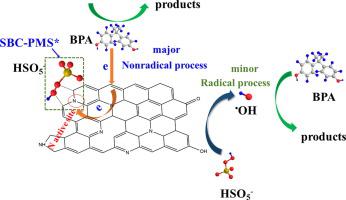Separation and Purification Technology ( IF 8.1 ) Pub Date : 2021-05-08 , DOI: 10.1016/j.seppur.2021.118909 Xiaohui Fan , Heng Lin , Jinjin Zhao , Yican Mao , Jiaxing Zhang , Hui Zhang

|
Activation of peroxymonosulfate (PMS) for organic-contaminated water remediation is a promising strategy. In this study, a sludge-derived biochar (SBC) was prepared as an efficient and low-cost metal-free catalyst to activate PMS for the abatement of bisphenol A (BPA) in water. The results demonstrate that BPA could be rapidly oxidized by the combination of SBC and PMS. Compared with the slight adsorption (8.1%) by SBC alone and limited direct oxidation (2.4%) by sole PMS, the removal efficiency of BPA was boosted to 94.5% within 60 min in the presence of both SBC and PMS. Active species participating in the rapid elimination of BPA were investigated via both chemical quenching experiment and electron paramagnetic resonance (EPR) technique. The results indicate that non-radical rather than radical process plays an important role in BPA abatement in the SBC/PMS system. The electron-transfer non-radical process was further verified by the open circuit potential test. It is proposed that PMS is bound to SBC to form a surface reactive complex (SBC-PMS*), which would abstract the electrons from the adsorbed BPA through the conductive carbon tunnel. The present work provides an alternative of controlling waste by waste.
中文翻译:

污水污泥生物炭基催化剂活化过氧单硫酸盐以有效去除双酚A:性能和机理
活化过氧单硫酸盐(PMS)进行有机污染的水修复是一种有前途的策略。在这项研究中,污泥衍生的生物炭(SBC)被制备为一种高效且低成本的无金属催化剂,可以激活PMS来消除水中的双酚A(BPA)。结果表明,SBC和PMS的结合可以快速氧化BPA。与仅SBC的轻微吸附(8.1%)和单独PMS的有限直接氧化(2.4%)相比,在SBC和PMS共同存在下,在60分钟内BPA的去除效率提高到94.5%。通过化学猝灭实验和电子顺磁共振(EPR)技术研究了参与快速消除BPA的活性物质。结果表明,非自由基过程而非自由基过程在SBC / PMS系统的BPA减排中起着重要作用。通过开路电势测试进一步验证了电子转移非自由基过程。建议将PMS与SBC结合形成表面反应性络合物(SBC-PMS *),该表面络合物将通过导电碳隧道从吸附的BPA中提取出电子。本工作提供了一种通过废物控制废物的替代方法。











































 京公网安备 11010802027423号
京公网安备 11010802027423号